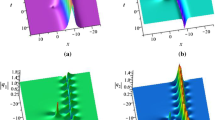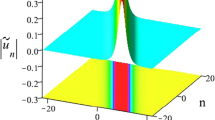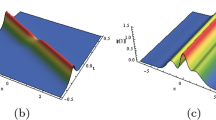Abstract
In this paper, we study a non-compatible fully PT symmetric Davey–Stewartson system by removing compatible condition of potential field from compatible case. This move makes the first two equations to be inconsistent and brings to the surface a more general Davey–Stewartson system. One major difference between them is that non-compatibility renders more possible solutions. The such system models evolution of optical wave packet in nonlinear optics and provides two spatial dimensional analogues of the integrable nonlocal nonlinear Schrödinger equation. Next, via Hirota’s method and long wave limit, various kinds of solutions are obtained. N-soliton is deduced by Hirota’s bilinear form, while rational and semi-rational solutions are constructed by applying long wave limit to N-soliton solution. The rational solutions can be classified as kink-shaped, W-shaped and two crossed W-shaped rogue waves. The semi-rational solutions display as hybrids of rogue wave in periodic background, two rogue waves in periodic background, lump and Akhmediev breather in constant background, lump and Akhmediev breather in periodic background. Additionally, we give a detailed comparison between compatible and non-compatible Davey–Stewartson systems to clarify their differences. The proposed method might be useful in solving Hamiltonian systems, and it is essential to look into other symmetric reductions.














Similar content being viewed by others
Data availability
Data sharing not applicable to this article as no datasets were generated or analyzed during the current study.
References
Gardenr, C.S., Greene, J.M., Kruskal, M.D., Miura, R.M.: Method for solving the Korteweg-deVries equation. Phys. Rev. Lett. 19, 1095–1098 (1967)
Lax, P.D.: Integrals of nonlinear equations of evolution and solitary waves. Comm. Pure. Appl. Math. 21, 467–490 (1968)
Zakharov, V.E., Shabat, A.B.: Exact theory of two-dimensional self-focusing and one-dimensional self-modulation of waves in nonlinear media. Sov. Phys. JETP. 34, 62–69 (1972)
Ablowitz, M.J., Kaup, D.J., Newell, A.C., Segur, H.: Inverse scattering transform: fourier analysis for nonlinear problems. Stud. Appl. Math. 53, 249–315 (1974)
Ablowitz, M.J., Musslimani, Z.H.: Inverse scattering transform for the integrable nonlocal nonlinear Schrödinger equation. Nonlinearity 29, 915–946 (2016)
Bender, C.M., Brody, D.C., Jones, H.F., Meister, B.K.: Faster than Hermitian quantum mechanics. Phys. Rev. Lett. 98, 040403 (2007)
Bessis, D.: Private communication
Bender, C.M., Boettcher, S.: Real spectra in non-Hermitian Hamiltonians having PT symmetry. Phys. Rev. Lett. 80, 5243–5246 (1998)
Streater, R.F., Wightman, A.S.: PCT, Spin and statistics, and all that. New York, (1964)
Bender, C.M., Milton, K.A.: Nonperturbative calculation of symmetry breaking in quantum field theory. Phys. Rev. D. 55, 3255–3259 (1997)
Bender, C.M., Milton, K.A.: Model of supersymmetric quantum field theory with broken parity symmetry. Phys. Rev. D. 70, 3595–3608 (1998)
Bender, C.M., Brody, D.C., Jones, H.F.: Extension of PT-symmetric quantum mechanics to quantum field theory with cubic interaction. Phys. Rev. D. 57, 025001 (2004)
Ablowitz, M.J., Musslimani, Z.H.: Integrable nonlocal nonlinear equations. Stud. Appl. Math. 139, 7–59 (2017)
Rao, J.G., He, J.S., Mihalache, D., Cheng, Y.: PT-symmetric nonlocal Davey-Stewartson I equation: general lump-soliton solutions on a background of periodic line waves. Appl. Math. Lett. 104, 106246 (2020)
Qian, C., Rao, J.G., Mihalache, D., He, J.S.: Rational and semi-rational solutions of the y-nonlocal Davey-Stewartson I equation. Comput. Math. Appl. 75, 3317–3330 (2018)
Rao, J.G., Zhang, Y.S., Fokas, A.S., He, J.S.: Rogue waves of the nonlocal Davey-Stewartson I equation. Nonlinearity 31, 4090–4107 (2018)
Rao, J.G., Cheng, Y., Porsezian, K., Mihalache, D., He, J.S.: PT-symmetric nonlocal Davey-Stewartson I equation: soliton solutions with nonzero background. Physica. D. 401, 132180 (2020)
Wang, S.N., Yu, G.F.: Rational and semi-rational solutions to the Davey-Stewartson III equation. Nonlinear, Dyn (2023)
Liu, Y.B., Mihalache, D., He, J.S.: Families of rational solutions of the y-nonlocal Davey-Stewartson II equation. Nonlinear. Dyn. 90, 2445–2455 (2017)
Ding, C.C., Zhou, Q., Triki, H., Sun, Y.Z., Biswas, A.: Dynamics of dark and anti-dark solitons for the x-nonlocal Davey-Stewartson II equation. Nonlinear. Dyn. 111, 2621–2629 (2021)
Cao, Y.L., He, J.S., Mihalache, D.: Families of exact solutions of a new extended (2+1)-dimensional Boussinesq equation. Nonlinear. Dyn. 91, 2593–2605 (2018)
Guo, J.T., He, J.S., Li, M.H., Mihalache, D.: Exact solutions withe elastic interaction for the (2+1)-dimensional extended Kadomtsev-Petviashvili equation. Nonlinear. Dyn. 101, 2413–2422 (2020)
Yang, B., Chen, Y.: Reductions of Darboux transformations for the PT-symmetric nonlocal Davey-Stewartson equations. Appl. Math. Lett. 82, 43–49 (2018)
Yang, B., Chen, Y.: Dynamics of rogue waves in the partially PT-symmetric nonlocal Davey-Stewartson systems. Commun. Nonlinear. Sci. Numer. Simulat. 69, 287–303 (2019)
Su, J.J., Zhang, S.: Nth-order rogue waves for the AB system via the determinants. Appl. Math. Lett. 112, 106714 (2021)
Su, J.J., Ruan, B.: N-fold binary Darboux transformation for the nth-order Ablowitz-Kaup-Newell-Segur system under a pseudo-symmetry hypothesis. Appl. Math. Lett. 125, 107719 (2022)
Liu, Y.B., Fokas, A.S., Mihalache, D., He, J.S.: Parallel line rogue waves of the third-type Davey-Stewartson equatiom. Rom. Rep. Phys. 68, 1425–1446 (2016)
Rao, J.G., Porsezian, K., He, J.S.: Semi-rational solutions of the third-type Davey-Stewartson equation. Chaos 27, 083115 (2017)
Luo, H.T., Wang, L., Zhang, Y.B., Lu, G., Su, J.J., Zhao, Y.C.: Data-driven solutions and parameter discovery of the Sasa-Satsuma equation via the physics-informed neural networks method. Physica. D. 440, 133489 (2022)
Zhang, S., Lan, P., Su, J.J.: Wave-packet behaviors of the defocusing nonlinear Schrödinger equation based on the modified physics-informed neural networks. Chaos. 31, 113107 (2021)
Hirota, R.: The direct method in soliton theory. Springer, Berlin (2004)
Rao, J.G., Cheng, Y., He, J.S.: Rational and semi-rational solutions of the nonlocal Davey-Stewartson equations. Stud. Appl. Math. 139, 568–598 (2017)
Kodama, Y.: Young diagrams and N-soliton solutions of the KP equation. J. Phys. A. Math. Gen. 37, 11169–11190 (2004)
Kedziora, D.J., Ankiewicz, A., Akhmediev, N.: Rogue waves and solitons on a cnoidal background. Eur. Phys. J. Special. Topics. 223, 43–62 (2014)
Ma, Y.L., Wazwaz, A.M., Li, B.Q.: New extended Kadomtsev-Petviashvili equation: multiple soliton solutions, breather, lump and interaction solutions. Nonlinear. Dyn. 104, 1581–1594 (2021)
Ablowitz, M.J., Satsuma, J.: Solitons and rational solutions of nonlinear evolution equations. J. Math. Phys. 19, 2180 (1978)
Wang, L.Y., Gao, B.: Exact solutions to the fractional complex Ginzburg-Landau equation with time-dependent coefficients under quadratic-cubic and power law nonlinearities. Nonlinear. Dyn. 111, 4709–4722 (2023)
Sun, B.N.: General soliton solutions to a nonlocal long-wave-short-wave resonance interaction equation with nonzero boundary condition. Nonlinear. Dyn. 92, 1369–1377 (2018)
Akhmediev, N., Ankiewicz, A., Soto-Crespo, J.M.: Rogue waves and rational solutions of the nonlinear Schrödinger equation. Phys. Rev. E. 80, 026601 (2009)
Akhmediev, N., Pelinovsky, E.: Discussion and debate: rogue waves-towards a unifying concept? Eur. Phys. J. Spec. Top. 184, 1–266 (2010)
Akhmediev, N., Ankiewicz, A., Taki, M.: Waves that appear from nowhere and disappear without a trace. Phys. Lett. A. 373, 675–678 (2009)
Su, J.J., Gao, Y.T., Deng, G.F., Jia, T.T.: Solitary waves, breathers, and rogue waves modulated by long waves for a model of a baroclinic shear flow. Phys. Rev. E. 100, 042210 (2019)
Su, J.J., Deng, G.F.: Quasi-periodic waves and irregular solitary waves of the AB system. Wave. Random. Complex. 32, 856–866 (2020)
Su, J.J., Zhang, S., Ding, C.C.: Spatiotemporal distortion effects and interaction properties for certain nonlinear waves of the generalized AB system. Nonlinear. Dyn. 106, 2415–2429 (2021)
Li, L.F., Xie, Y.Y., Mei, L.Q.: Multiple-order rogue waves for the generalized (2+1)-dimensional Kadomtsev-Petviashvili equation. Appl. Math. Lett. 117, 107079 (2021)
Author information
Authors and Affiliations
Corresponding author
Ethics declarations
Conflict of interest
The authors declare that they have no conflict of interest.
Additional information
Publisher's Note
Springer Nature remains neutral with regard to jurisdictional claims in published maps and institutional affiliations.
Appendix
Appendix
where
\(\vartheta _j,b_j,\tau _{ij}(1\le i<j\le 4),\eta _5,\hbar _5\) is defined in (2.3), (2.4), (2.5) and (3.2).
where
\(\vartheta _s,b_s,\tau _{sl},\eta _l,\hbar _l,e^{A_{34}},e^{A_{35}},e^{A_{45}}\) is defined in (2.3), (2.4), (2.5) and (3.2).
Rights and permissions
Springer Nature or its licensor (e.g. a society or other partner) holds exclusive rights to this article under a publishing agreement with the author(s) or other rightsholder(s); author self-archiving of the accepted manuscript version of this article is solely governed by the terms of such publishing agreement and applicable law.
About this article
Cite this article
Li, L., Zhu, M., Niu, Y. et al. Non-compatible fully PT symmetric Davey–Stewartson system: soliton, rogue wave and breather in nonzero wave background. Nonlinear Dyn 111, 16407–16426 (2023). https://doi.org/10.1007/s11071-023-08696-0
Received:
Accepted:
Published:
Issue Date:
DOI: https://doi.org/10.1007/s11071-023-08696-0




